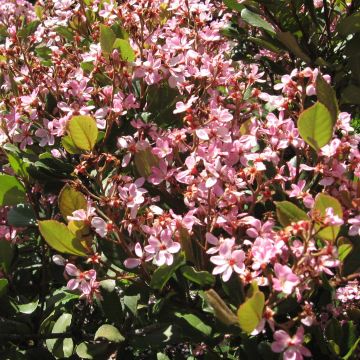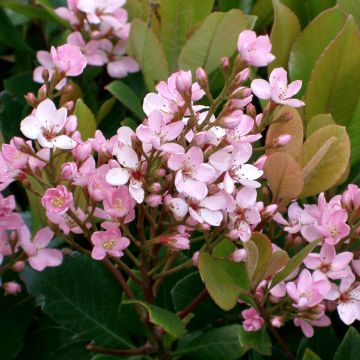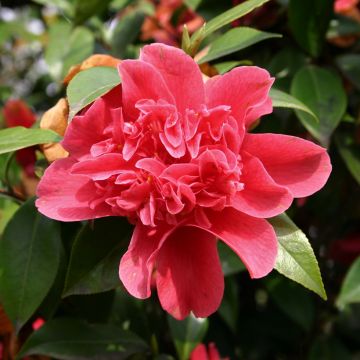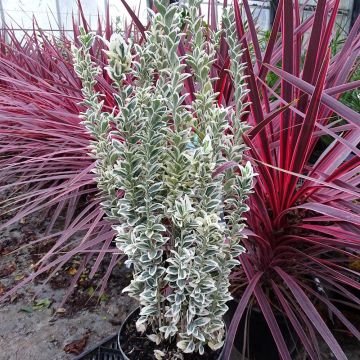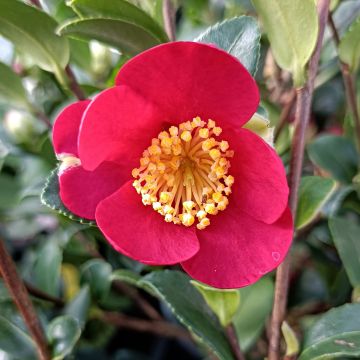

Rhaphiolepis umbellata (japonica)


Rhaphiolepis umbellata (japonica)


Rhaphiolepis umbellata (japonica)


Rhaphiolepis umbellata (japonica)
Rhaphiolepis umbellata (japonica)
Rhaphiolepis umbellata
Rhaphiolépide du Japon
This item cannot be shipped to the selected country
Delivery charge from €5.90
More information
Schedule delivery date,
and select date in basket
This plant carries a 24 months recovery warranty
More information
We guarantee the quality of our plants for a full growing cycle, and will replace at our expense any plant that fails to recover under normal climatic and planting conditions.
From €5.90 for pickup delivery and €6.90 for home delivery
Express home delivery from €8.90.
Does this plant fit my garden?
Set up your Plantfit profile →
Description
Rhaphiolepis umbellata, also known as Yeddo Hawthorn, is a beautiful evergreen shrub with a slick and elegant appearance, perfectly suited for small spaces or for container growing on a sunny terrace. It produces clusters of small white flowers in early summer, sometimes tinged with pink, simple yet charming, pleasantly fragrant, followed by dark blue-black berries that persist throughout the winter. In areas that are not too cold or near the coast, it can be used to mark a corner or to create striking contrast in a pattern made of other small evergreen shrubs.
Rhaphiolepis umbellata is a shrub in the Rosaceae family native to warm and relatively dry regions of the Far East (Japan and Korea). Rhaphiolepis plants are perfectly adapted to Mediterranean or oceanic climates.
It is a compact and spreading bush that will not exceed 1.20m (4ft) in height and 1.50m (5ft) in width. Its growth is slow. The evergreen foliage is composed of leathery, entire, and spatulate leaves, 5 to 8 cm long, with almost smooth edges. When they first emerge, they are covered with a layer of fine grey hairs, then take on a dark bronze-green colour, with a shiny finish. The young branches are reddish-brown. This harmony of colours makes Rhaphiolepis interesting throughout the year. It flowers from May to June, depending on the climate. At the end of each branch, a conical cluster, 5 to 10 cm long, bears several dozen of small star-shaped flowers, 1 to 2 cm in diameter, pleasantly fragrant. These flowers are usually white, sometimes tinged with light pink, and have a centre with purple stamens. The flowering is followed by the formation of small ovoid berries, less than 1 cm in size, initially red and then turning blue-black when ripe, which persist on the branches for a long time. Fresh seeds germinate very easily and quickly, within 8 days.
Rhaphiolepis umbellata is a dense shrub, with a very neat appearance, abundant flowering, and a delightful fragrance. If your climate and soil allow it, plant it in a flower bed or a small hedge, but it will also thrive on a sheltered and sunny terrace. While it dislikes excessive limestone in the soil, freezing winds, and cold winters, it is not bothered by sea spray, heat, or dry summers once established and can even flower in partially shaded areas. It is useful in coastal gardens to accompany Olearias, Escallonias, and Atriplex for example. In a large flower bed, it can be combined with cistus, lavenders, Hebe, or spring-flowering shrubs such as Callistemons, Leptospermum, and Melaleuca. It also adapts well to container gardening and can be overwintered in a frost-free location.
Report an error about the product description
Rhaphiolepis umbellata (japonica) in pictures


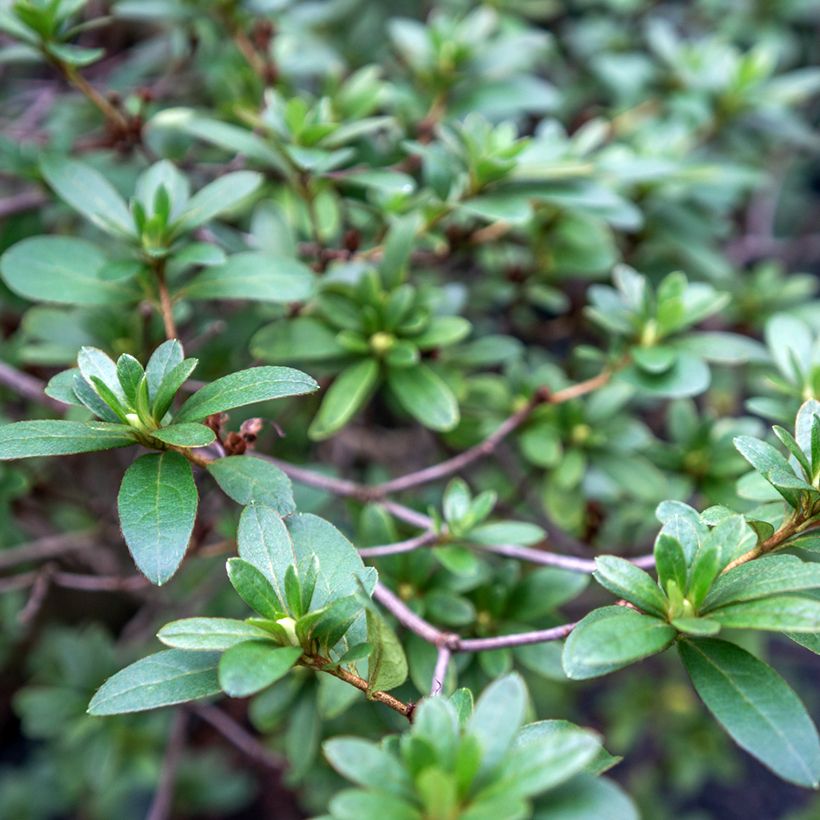





Plant habit
Flowering
Foliage
Botanical data
Rhaphiolepis
umbellata
Rosaceae
Rhaphiolépide du Japon
Southeast Asia
Other Rhaphiolepis
Planting and care
Rhaphiolepis umbellata is best planted in spring, or in autumn in very mild climates. Its growth is slow, but it has a long lifespan in the garden. It requires well-drained soils, preferably fresh, but it can also tolerate drought once well established. An acidic, neutral, or even clayey and slightly chalky soil is suitable, as long as it is loosened and amended with coarse sand and leaf compost. Choose a sheltered and warm location, protected from cold and dry winds. It blooms more abundantly in the sun, but tolerates semi-shaded exposures, especially in hot climates. Once well established, it requires no watering in summer, even in dry areas. It withstands sea spray, but not cold winter winds. Optionally, apply a rose fertiliser in spring if your soil is very poor. It dislikes heavy soils and dreads stagnant moisture, especially in winter. If the soil is too heavy and chalky, it can suffer from chlorosis; if this is the case, apply a dose of iron chelate every year in spring. This shrub is not particularly susceptible to diseases and pests. In cold regions, grow it in containers and overwinter it indoors during severe frosts.
Perform light pruning immediately after spring flowering to remove faded flowers.
Planting period
Intended location
Care
-
, onOrder confirmed
Reply from on Promesse de fleurs
Evergreen shrubs
Haven't found what you were looking for?
Hardiness is the lowest winter temperature a plant can endure without suffering serious damage or even dying. However, hardiness is affected by location (a sheltered area, such as a patio), protection (winter cover) and soil type (hardiness is improved by well-drained soil).

Photo Sharing Terms & Conditions
In order to encourage gardeners to interact and share their experiences, Promesse de fleurs offers various media enabling content to be uploaded onto its Site - in particular via the ‘Photo sharing’ module.
The User agrees to refrain from:
- Posting any content that is illegal, prejudicial, insulting, racist, inciteful to hatred, revisionist, contrary to public decency, that infringes on privacy or on the privacy rights of third parties, in particular the publicity rights of persons and goods, intellectual property rights, or the right to privacy.
- Submitting content on behalf of a third party;
- Impersonate the identity of a third party and/or publish any personal information about a third party;
In general, the User undertakes to refrain from any unethical behaviour.
All Content (in particular text, comments, files, images, photos, videos, creative works, etc.), which may be subject to property or intellectual property rights, image or other private rights, shall remain the property of the User, subject to the limited rights granted by the terms of the licence granted by Promesse de fleurs as stated below. Users are at liberty to publish or not to publish such Content on the Site, notably via the ‘Photo Sharing’ facility, and accept that this Content shall be made public and freely accessible, notably on the Internet.
Users further acknowledge, undertake to have ,and guarantee that they hold all necessary rights and permissions to publish such material on the Site, in particular with regard to the legislation in force pertaining to any privacy, property, intellectual property, image, or contractual rights, or rights of any other nature. By publishing such Content on the Site, Users acknowledge accepting full liability as publishers of the Content within the meaning of the law, and grant Promesse de fleurs, free of charge, an inclusive, worldwide licence for the said Content for the entire duration of its publication, including all reproduction, representation, up/downloading, displaying, performing, transmission, and storage rights.
Users also grant permission for their name to be linked to the Content and accept that this link may not always be made available.
By engaging in posting material, Users consent to their Content becoming automatically accessible on the Internet, in particular on other sites and/or blogs and/or web pages of the Promesse de fleurs site, including in particular social pages and the Promesse de fleurs catalogue.
Users may secure the removal of entrusted content free of charge by issuing a simple request via our contact form.
The flowering period indicated on our website applies to countries and regions located in USDA zone 8 (France, the United Kingdom, Ireland, the Netherlands, etc.)
It will vary according to where you live:
- In zones 9 to 10 (Italy, Spain, Greece, etc.), flowering will occur about 2 to 4 weeks earlier.
- In zones 6 to 7 (Germany, Poland, Slovenia, and lower mountainous regions), flowering will be delayed by 2 to 3 weeks.
- In zone 5 (Central Europe, Scandinavia), blooming will be delayed by 3 to 5 weeks.
In temperate climates, pruning of spring-flowering shrubs (forsythia, spireas, etc.) should be done just after flowering.
Pruning of summer-flowering shrubs (Indian Lilac, Perovskia, etc.) can be done in winter or spring.
In cold regions as well as with frost-sensitive plants, avoid pruning too early when severe frosts may still occur.
The planting period indicated on our website applies to countries and regions located in USDA zone 8 (France, United Kingdom, Ireland, Netherlands).
It will vary according to where you live:
- In Mediterranean zones (Marseille, Madrid, Milan, etc.), autumn and winter are the best planting periods.
- In continental zones (Strasbourg, Munich, Vienna, etc.), delay planting by 2 to 3 weeks in spring and bring it forward by 2 to 4 weeks in autumn.
- In mountainous regions (the Alps, Pyrenees, Carpathians, etc.), it is best to plant in late spring (May-June) or late summer (August-September).
The harvesting period indicated on our website applies to countries and regions in USDA zone 8 (France, England, Ireland, the Netherlands).
In colder areas (Scandinavia, Poland, Austria...) fruit and vegetable harvests are likely to be delayed by 3-4 weeks.
In warmer areas (Italy, Spain, Greece, etc.), harvesting will probably take place earlier, depending on weather conditions.
The sowing periods indicated on our website apply to countries and regions within USDA Zone 8 (France, UK, Ireland, Netherlands).
In colder areas (Scandinavia, Poland, Austria...), delay any outdoor sowing by 3-4 weeks, or sow under glass.
In warmer climes (Italy, Spain, Greece, etc.), bring outdoor sowing forward by a few weeks.

































